Bullish on Energy: Pitt Center for Energy at Forefront of Critical, Specific Energy Challenges
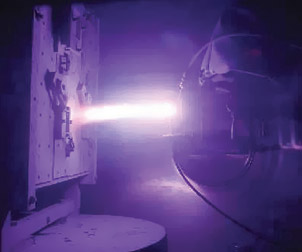 Developing advanced materials for energy-related applications is a key initiative in Pitt’s Center for Energy. This includes experimental and computation efforts on structural and functional materials for use in harsh environments (including those associated with nuclear systems), robust solar materials and devices, materials for energy storage, and thermoelectrics and sensors.
Developing advanced materials for energy-related applications is a key initiative in Pitt’s Center for Energy. This includes experimental and computation efforts on structural and functional materials for use in harsh environments (including those associated with nuclear systems), robust solar materials and devices, materials for energy storage, and thermoelectrics and sensors.Western Pennsylvania sits atop one of the largest reserves of natural gas in the country. The nation’s oil industry was born here. The region’s vast coal deposits, which led to an industrial revolution that largely began here, continue to feed the region’s electricity needs. Companies such as Westinghouse Electric Company have ensured that nuclear energy research remains firmly entrenched in the Pittsburgh area. And the U.S. Department of Energy’s National Energy Technology Laboratory (NETL) resides squarely within the region.
So it should come as little surprise that, today, University of Pittsburgh researchers embrace the enduring, pioneering spirit of the Pittsburgh region’s historic energy legacy with a growing diversity of collaborative, multidisciplinary research that spans the energy disciplines.
“This region historically has been rich in energy research and development, and the University of Pittsburgh for years has supported that legacy with its top-quality faculty and research programs,” says Vice Provost for Research George Klinzing. “We’re totally committed to energy research and development at Pitt, and we have a robust collaboration of unique talent driving our efforts. We’re really bullish on energy.”
But Pitt researchers are not just researching new ways to harness energy or other high-profile alternative energy solutions, Klinzing says. Helping to bridge energy’s past and its long-term future, they are delving into challenges surrounding what he describes as some of the most important underpinnings of a successful energy sector. “I call it the guts of energy —what makes the sector work more efficiently and effectively,” Klinzing says of Pitt’s unique focus on energy research. “It’s what makes energy tick.”
The researchers’ tools comprise a unique combination of basic, experimental science and sophisticated computer modeling and simulation that, Klinzing says, are key to solving some of the world’s most vexing energy challenges.
Indeed, researchers at Pitt today are using that combination to:
• Make coal into a more efficient and cleaner energy source and transform it into new synthetic fuels;
• Develop power-plant technologies that would lead to minimal carbon dioxide emissions, as well as novel methods to effectively reuse this greenhouse gas; and
• Design high-temperature valve systems for turbines that generate electricity.
In addition, they’re using new polymers, nanoscale particles, and other advanced materials to capture, convert and store energy, as well as protect energy-related equipment from extreme conditions such as intense heat or ice.
Other innovators at Pitt are studying more efficient ways to integrate sources of electrical power and distribute it to consumers. One research group is inventing new technologies to capture ambient radio-frequency energy to recharge implantable medical device batteries. Still others are developing new computer modeling tools and methodologies to dramatically enhance energy research. And Pitt is helping to lead a national consortium of five universities, called the Regional University Alliance, in a wide range of basic and applied research in partnership with NETL.
Pitt’s Center for Energy
Pitt’s Center for Energy, which was created in 2008 under an initiative led by the Office of the Provost, brings together this powerhouse of innovators and their diversity of research—from chemists and geologists to physicists, materials scientists, mechanical engineers, electrical engineers, and environmental engineers. The center is housed in the University’s Swanson School of Engineering.
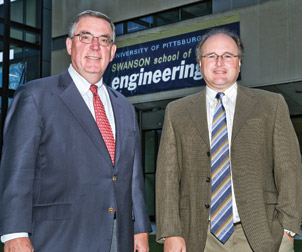 Among the initiators of Pitt’s formalized energy research activities were Pitt’s U.S. Steel Dean of Engineering Gerald D. Holder (left), and Brian Gleeson, Harry S. Tack Chair and Professor of Materials Engineering in Pitt’s Department of Mechanical Engineering and Materials Science. Their efforts, along with an initiative led by the Office of the Provost, eventually resulted in the 2008 creation of Pitt’s Center for Energy, housed in the Swanson School of Engineering and directed by Gleeson. Associate directors are Laura Schaefer, a professor of engineering in the Department of Mechanical Engineering, and Gregory Reed, a professor of electric power engineering in the Department of Electrical and Computer Engineering.
Among the initiators of Pitt’s formalized energy research activities were Pitt’s U.S. Steel Dean of Engineering Gerald D. Holder (left), and Brian Gleeson, Harry S. Tack Chair and Professor of Materials Engineering in Pitt’s Department of Mechanical Engineering and Materials Science. Their efforts, along with an initiative led by the Office of the Provost, eventually resulted in the 2008 creation of Pitt’s Center for Energy, housed in the Swanson School of Engineering and directed by Gleeson. Associate directors are Laura Schaefer, a professor of engineering in the Department of Mechanical Engineering, and Gregory Reed, a professor of electric power engineering in the Department of Electrical and Computer Engineering.The center’s director is Brian Gleeson, Harry S. Tack Chair and Professor of Materials Engineering in Pitt’s Department of Mechanical Engineering and Materials Science. Associate directors are Laura Schaefer, a professor of engineering in the Department of Mechanical Engineering, and Gregory Reed, a professor of electric power engineering in the Department of Electrical and Computer Engineering. These three top researchers manage their own research programs and provide leadership to the University’s overall energy endeavor.
The center’s goal is to better coordinate the University’s wide spectrum of in-depth energy research and facilitate innovative, multidisciplinary solutions to the world’s growing energy challenges.
“Energy really is the defining social, political, and economic problem of the 21st century,” Gerald Holder, U.S. Steel Dean of Engineering of the Swanson School of Engineering, says in explaining why the University has put such a strong emphasis on energy research. “The University of Pittsburgh has a long history in the energy discipline and will continue to develop it as one of the leading initiatives in engineering. It’s a priority.”
The center also gives the University the ability to collectively and more systematically develop stronger and more collaborative partnerships—including education and research—with such companies as Westinghouse Electric Corp., Eaton Corp., Consol Energy Inc., and other industry partners from Pittsburgh and beyond, according to Donald Shields, who serves as the center’s executive director. “We’re able to partner with them in both workforce development education programs and technical development, working to solve technical challenges,” Shields says. “One of the things we have an ability to do because of the scope of our collaborative energy research is leveraging the participation of these partners. It gives us bigger opportunities in competing for federal research funds.”
Today, the center’s 70-plus affiliated research faculty University-wide are striving to combine their diverse expertise to strengthen basic- and applied-research programs in primarily five key areas: energy delivery and reliability, carbon management and utilization, high-temperature and other advanced materials, energy efficiency, and unconventional gas resources. In the short-term, the center also hopes to develop an infrastructure that effectively transforms the research into commercially successful products and processes.
Integrating power
The importance of developing a more efficient electrical power transmission and distribution system becomes clear as more sources of electrical power generation begin to contribute electricity for general consumer use. That’s where Gregory Reed and his research team at Pitt become an important part of the energy equation.
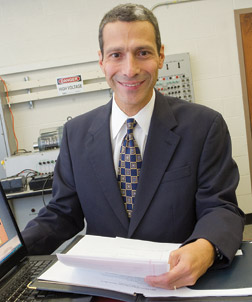 Gregory Reed, a professor of electric power engineering in the Swanson School’s Department of Electrical and Computer Engineering, is researching how to reduce instability in the nation’s electrical power grid, including methods to better implement advanced AC and DC power electronics control systems and to effectively integrate renewable energy resources into that grid. Reed, an associate director of Pitt’s Center for Energy, has extensive industry and academic experience in the electric power and energy arena.
Gregory Reed, a professor of electric power engineering in the Swanson School’s Department of Electrical and Computer Engineering, is researching how to reduce instability in the nation’s electrical power grid, including methods to better implement advanced AC and DC power electronics control systems and to effectively integrate renewable energy resources into that grid. Reed, an associate director of Pitt’s Center for Energy, has extensive industry and academic experience in the electric power and energy arena.In fact, Gleeson, referring to Reed’s research, says that “reducing grid instability and integrating renewable energy into the grid are crucial for the future of energy.”
Reed has been working for several years to foster educational programs in engineering in partnership with companies such as Eaton Corp., ABB Inc., Siemens Energy, and Mitsubishi Electric, among others. Out of that effort, he says, has emerged a growing research program focusing on advanced power electronics-based transmission and distribution technologies that help regulate the flow of electrical power throughout the power grid. Reed has more than 25 years of industry and academic experience in the electric power and energy arena. His research program, supported by at least six research faculty and more than a dozen full-time graduate students, targets several main areas. Among them are power electronics technologies for large-scale power delivery applications, including Flexible AC Transmission Systems, or FACTS; High-Voltage DC Transmission Systems (HVDC); and Medium-Voltage DC Systems (MVDC). In addition, the group also is studying new energy storage systems, smart-grid technologies, energy efficiency, and power quality. The research is supported by grants from the U.S. Department of Energy, the U.S. Department of Commerce, Pennsylvania’s Ben Franklin Technology Development Authority, the National Science Foundation, and a number of industry partners.
“There are a lot of applications to explore based on renewable energy integration and grid infrastructure development,” Reed says. “As a result, we are one of the fastest-growing university programs in the country in this area at this time. Our potential for growth is tremendous, and the contributions that we are making are having an impact on technology developments for our industry partners and other constituents.”
The efficiency factor
Laura Schaefer has taken on the challenge of developing more efficient energy systems. In recent years, she and her collaborators have received more than $10 million in funding from such organizations as the National Science Foundation, the Air Force Office of Scientific Research, and the American Society of Heating, Refrigerating, and Air-Conditioning Engineers. Schaefer’s research centers on the analysis, design, and optimization of energy systems, with an emphasis on improving energy efficiency and diversification for increased sustainability. She examines energy systems from a fundamentals viewpoint and within the context of environmental and societal impact. Among the energy systems she analyzes are absorption cycles, fuel cells, two-phase microchannel flow, multijunction solar cells, hydrokinetics, and thermoacoustics. She also is developing new algorithms and sensors for what she describes as the optimal operation of building systems and assessing hybrid fuel cell/turbine power generation life cycles.
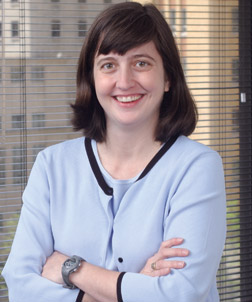 Laura Schaefer, a professor of engineering in the Department of Mechanical Engineering and an associate director of Pitt’s Center for Energy, focuses her research on the development of more efficient energy systems. In recent years, she and her collaborators have received more than $10 million in funding from such organizations as the National Science Foundation and the Air Force Office of Scientific Research. Schaefer’s research centers on the analysis, design, and optimization of energy systems, with an emphasis on improving energy efficiency and diversification for increased sustainability.
Laura Schaefer, a professor of engineering in the Department of Mechanical Engineering and an associate director of Pitt’s Center for Energy, focuses her research on the development of more efficient energy systems. In recent years, she and her collaborators have received more than $10 million in funding from such organizations as the National Science Foundation and the Air Force Office of Scientific Research. Schaefer’s research centers on the analysis, design, and optimization of energy systems, with an emphasis on improving energy efficiency and diversification for increased sustainability.Peyman Givi, meanwhile, has been focusing his research on turbulent combustion as part of an effort to increase fossil-fuel efficiency and reduce pollution associated with exhaust emissions. Givi, William Kepler Whiteford Professor in the Department of Mechanical Engineering and Materials Science, conducts much of his research in the Swanson School’s Laboratory for Computational Transport Phenomena. The lab, which he oversees, boasts high-speed minisupercomputers and graphic systems, as well as hardware and software for running simulations. Its state-of-the-art technology has allowed Givi to develop more accurate and comprehensive computer models of turbulent reacting flow and other efficiency targets.
William “Buddy” Clark and research collaborator Jeff Vipperman, both professors of mechanical engineering and materials science, have a partnership with NETL that has helped set the stage for a strong long-term relationship with the locally based federal energy lab. The pair was asked to develop a valve system for power plant gas turbines that would decrease emissions, control combustion instabilities, and provide fuel flexibility, allowing the turbines to burn conventional fuels such as methane as well as gases derived from coal, hydrogen, petrochemicals, cow manure, and other sources.
Clark and Vipperman’s research yielded a set of valves that could rapidly adjust fuel flow rate based on information obtained from a combustion sensor developed by NETL, Clark says. The research team now is working with Pitt’s Office of Technology Management, along with NETL, to commercialize the innovation.
Gleeson is quick to point to such collaborations and the complex problems they are solving as exemplary of the “underpinnings” of energy research being conducted at Pitt. “They’re a great research team,” he says of Clark and Vipperman. “Their partnership has been great in developing a long-term relationship with NETL, and it has led to some significant innovations. That’s what these partnerships are all about.”
Another promising technology—and one that also has emerged from a direct research partnership with NETL—is a new fuel sensor technology developed by Joel Falk, a professor of electrical and computer engineering, and his research team. The sensor measures and controls the composition of gases going into and coming out of gas power plant turbines, allowing for maximum efficiency. The technology is in the process of being commercialized with an outside commercial partner.
Also tackling efficiency issues with gas turbines is Minking Chyu, the Leighton and Mary Orr Chair Professor and chair of the Department of Mechanical Engineering and Materials Science. Chyu focuses primarily on thermal and material issues related to energy, power and propulsion systems, material processing, and micro/nanosystem technology. Recent research projects include convective cooling of gas turbine airfoils, nanofluid applications in heat transfer and oil and gas exploration, and thermal measurement and imaging techniques.
Taking the heat…and other advanced materials challenges
Potential new fuel sources are posing additional scientific challenges when it comes to electric power turbines and the high levels of heat created during power generation. Pitt researchers, armed with advanced-materials expertise linked partly to earlier ties to the region’s steel industry, see such heat as an opportunity for innovation.
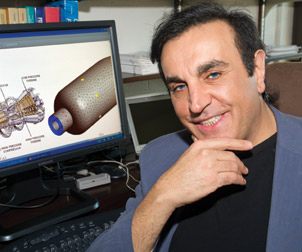 Peyman Givi’s research focuses on turbulent combustion as part of an effort to increase fossil-fuel efficiency and reduce pollution associated with exhaust emissions. Givi, William Kepler Whiteford Professor in the Department of Mechanical Engineering and Materials Science and director of the Laboratory for Computational Transport Phenomena at Pitt, uses advanced simulation and modeling to provide an accurate way for engineers to experiment with engines even before they are built. Rolls-Royce and NASA engineers already use Givi’s model to predict temperature differential, fuel usage, and emissions for different engine and fuel combinations.
Peyman Givi’s research focuses on turbulent combustion as part of an effort to increase fossil-fuel efficiency and reduce pollution associated with exhaust emissions. Givi, William Kepler Whiteford Professor in the Department of Mechanical Engineering and Materials Science and director of the Laboratory for Computational Transport Phenomena at Pitt, uses advanced simulation and modeling to provide an accurate way for engineers to experiment with engines even before they are built. Rolls-Royce and NASA engineers already use Givi’s model to predict temperature differential, fuel usage, and emissions for different engine and fuel combinations. Take Gerald Meier, William Kepler Whiteford Professor in Pitt’s Department of Mechanical Engineering and Materials Science, and Brian Gleeson, for instance. Both are exploring the potential development of new materials that would allow solid oxide fuel cells and hydrogen turbines to stand up more effectively to extremely high temperatures. Both are investigating, for example, viable new combinations of metals and ceramics for thermal barrier coatings that might better insulate turbine components typically found in aircraft and ship engines and power generators, while allowing for the generation of greater heat. The thermal barrier coatings that Meier and Gleeson are studying usually are used on aircraft engine turbines to achieve improved engine efficiency and durability.
Funding some of Meier and Gleeson’s research is the U.S. Office of Naval Research (ONR), which is interested in better aircraft and ship performance and is cognizant of the fact that a hotter turbine amounts to more thrust from an engine. But the research collaborators also contend that the same science can be applied to turbines in power plants to make them more efficient.
Gleeson and Meier are also working on a number of research projects to improve the performance of materials used at high temperatures and in other severe environments. These projects, funded by the U.S. Department of Energy, ONR and other federal agencies, and industry, focus on surface degradation, protective coatings, and life-prediction modeling.
Harnessing (more) sun
In the University’s Department of Chemistry, other researchers are developing new materials to better harness the immense spectrum of sunlight by using the tiniest of particles. David Waldeck, a professor and chair in the School of Arts and Science’s Department of Chemistry, is exploring ways to provide a systematic and modular approach to creating a new generation of solar energy conversion devices using nanoparticle-based materials.
His research team, which includes researchers from Duke University and the Weizmann Institute of Science in Israel, is working to design, synthesize, and provide characterization of linked nanoparticle assemblies that will provide a charge separation “engine” in solar cells. The cells, in turn, then should be able to capture the entire available range of solar irradiance.
Back in the Swanson School, meanwhile, nanoscientist Hong Koo Kim has developed a new method of light coupling in solar cells using nano-optic structures. His innovation, which is being characterized as a platform technology and referred to as “solar-nano,” has the potential to significantly increase the efficiency of solar cells in capturing photons and converting them to electrons via photovoltaic cells. Kim is the Bell of Pennsylvania/Bell Atlantic Professor, Department of Electrical and Computer Engineering, and codirector of Pitt’s Petersen Institute of NanoScience and Engineering. Kim has struck a research partnership with Pennsylvania-funded Innovation Works and its energy initiative to commercialize the technology.
“It would be a paradigm shift in how light is captured [in solar cells],” says Harold Swift, a licensing manager with Pitt's Office of Technology Management (OTM) who is helping to facilitate the commercialization effort with Kim. “Hong Koo Kim really is a pioneer in nanotechnology, particularly in the area of nano-optics.”
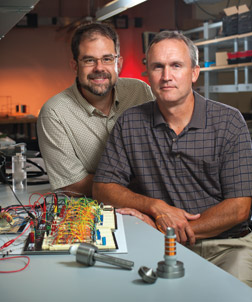 William “Buddy” Clark (right) and Jeff Vipperman, both Pitt professors of mechanical engineering and materials science, were asked by the National Energy Technology Lab (NETL) to develop a valve system for power plant gas turbines that would decrease emissions, control combustion instabilities, and provide fuel flexibility, allowing the turbines to burn conventional fuels such as methane as well as gases derived from coal, hydrogen, petrochemicals, cow manure, and other sources. Clark and Vipperman’s research yielded a set of valves that could rapidly adjust fuel flow rate based on information obtained from a combustion sensor developed by NETL, Clark says. The research team now is working with Pitt’s Office of Technology Management, along with NETL, to commercialize the innovation.
William “Buddy” Clark (right) and Jeff Vipperman, both Pitt professors of mechanical engineering and materials science, were asked by the National Energy Technology Lab (NETL) to develop a valve system for power plant gas turbines that would decrease emissions, control combustion instabilities, and provide fuel flexibility, allowing the turbines to burn conventional fuels such as methane as well as gases derived from coal, hydrogen, petrochemicals, cow manure, and other sources. Clark and Vipperman’s research yielded a set of valves that could rapidly adjust fuel flow rate based on information obtained from a combustion sensor developed by NETL, Clark says. The research team now is working with Pitt’s Office of Technology Management, along with NETL, to commercialize the innovation.Mingui Sun, a professor of neurological surgery, bioengineering, and electrical engineering, likewise is targeting the sun, but with a novel wireless energy transmission technology that can transmit significant levels of energy, captured via solar-panel systems, safely through walls (or roofs) and spaces without any direct wire cable connections. His innovation, Sun says, uses uniquely designed oscillating thin-film coils and resonators to convert electrical energy to magnetic energy over short distances to either electricity storage devices or directly to electrical devices.
The value proposition of the innovation, Sun contends, is that it alleviates the traditional need for complicated—and expensive—solar panel installation procedures that require, for example, holes in a rooftop through which to run wiring into a home. Sun also is working with Pitt’s OTM to commercialize his technology.
Unconventional gas
Few could argue that the Marcellus Shale geologic formation spanning Pennsylvania and parts of Ohio, West Virginia, Maryland, and New York has proven a boon for the energy industry, particularly in Pennsylvania. It’s considered unconventional, of course, because of the nature of the deposits—and the way natural gas must be extracted, which includes deep and then horizontal drilling before pushing a pressurized water slurry into the hole to “fracture” the shale deposits and release the gas from the rock.
The process has provided many new opportunities for the use of natural gas and has created new jobs and even new industries in the region. But it also has created a gusher of new scientific challenges—which means lots of collaborative research opportunities for University researchers, who happen to sit in the heart of Marcellus drilling country.
Perhaps one of the most pressing issues is the proper management of water used in the process, according to Radisav Vidic, William Kepler Whiteford Professor and Chair in Pitt’s Department of Civil and Environmental Engineering, who has added this issue to his portfolio of research endeavors. Horizontal drilling and multistage hydraulic fracturing requires the use of millions of gallons of water mixed with other materials. Vidic is studying the resulting polluted water, including its movement before, during, and after the fracturing process.
Gleeson and others at Pitt currently are in the early stages of developing increased research focusing on unconventional gas, covering everything from flow-back water management and naturally occurring radioactive matter to health, safety, transportation, and even workforce development issues.
Carbon challenges
Despite a national push toward new and renewable energy sources, coal and other fossil fuels still predominate when it comes to energy production. Thus, Pitt researchers also continue to study coal, its carbon properties, uses, byproducts, environmental impact, and other related issues. Such coal research remains imperative, at least in the foreseeable future, because the nation’s plentiful coal reserves continue to fuel the generation of at least 50 percent of the nation’s electricity, according to the DOE’s Energy Information Administration. As such, Pitt faculty members, many supported by research partnerships with NETL and its fossil fuel research interests, are discovering better ways to burn coal, convert coal into cleaner-burning synthetic fuels, and build better turbines and fuel cells that would use those synthetic fuels. University researchers also are tackling such issues as how to reduce or eliminate the emission of carbon dioxide produced by power plants that burn coal and how to store, use, or reuse greenhouse gas rather than releasing it into the atmosphere.
Badie Morsi, a professor of chemical and petroleum engineering at Pitt, offers his own vision for coal’s future, saying it begins with developing much cleaner and energy-efficient coal-derived fuels. Morsi, who serves as director of the University’s petroleum engineering program, says he is applying 21st-century innovation to a technology that was first developed and used in the 1920s.
Morsi is working to improve the gasification process to work more effectively and cleanly with modern coal gasifiers. As he explains, today’s gasifiers use high pressure and temperature, add oxygen or steam to break down the coal into its original components, and then set off a chemical reaction that produces hydrogen, carbon monoxide, and carbon dioxide. The resulting hydrocarbons then can be used to produce diesel, gasoline, jet fuel, and lubricating oil, among others. Morsi’s current research focuses on designing and scaling up multiphase reactors, such as bubble columns, slurry bubble columns, high-pressure/temperature-stirred vessels, membrane reactors, and trickle-bed reactors. He also is conducting computer modeling and optimization tests on these chemical processes.
William Harbert, a professor of geophysics in Pitt’s Department of Geology and Planetary Science, believes that capturing carbon dioxide (CO2) from power plants and safely sequestering it underground in the long term is possible. After all, oil recovery workers already pump CO2 into reservoir rock made from compressed sand, forcing hydrocarbons out of the ground. The big question, he asks, is, “Is it staying there?”
The geophysicist and his research team are using 4-D seismic data to study such CO2 sequestration sites before and after CO2 is injected into the geological reservoirs—and then six months later, to see whether the CO2 is staying there.
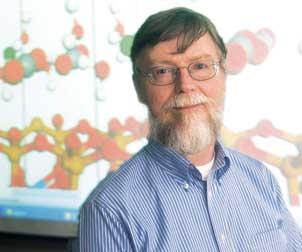 Distinguished Professor of Computational Chemistry Kenneth Jordan is studying CO2 with particular emphasis on how to capture and store it as well as on how to convert it into fuels. Among several of Jordan’s recent projects is a NETL-funded study of the use of clay materials to capture and store CO2. The background of the above photo of jordan shows images of CO2molecules trapped in interlayer water in a clay sample.
Distinguished Professor of Computational Chemistry Kenneth Jordan is studying CO2 with particular emphasis on how to capture and store it as well as on how to convert it into fuels. Among several of Jordan’s recent projects is a NETL-funded study of the use of clay materials to capture and store CO2. The background of the above photo of jordan shows images of CO2molecules trapped in interlayer water in a clay sample.Distinguished Professor of Computational Chemistry Kenneth Jordan also is studying CO2 and how to store it safely and effectively. But he’s just as interested, he says, in finding ways to essentially reactivate it out of storage via chemical transformations and temperature changes and even using CO2 as a mechanism for transporting energy.
Among several of Jordan’s recent projects is a NETL-funded study of the use of clay materials to capture and hold CO2 for future reuse and the role played by water in absorbing CO2.
Another NETL-funded project focuses on the use of so-called ionic fluids for storage and reuse. “Our interest is in an inexpensive medium in which you can capture and store CO2 long-term—one that you can later heat up or whose pressure you can change in order to release the CO2 again,” Jordan says.
Jordan, who also is the director of the University’s Center for Molecular and Materials Simulations, says he also is researching the use of sunlight to convert CO2 and water-derived hydrogen into useful products like methanol and methane.
What brings all of Jordan’s research together is his pioneering use of computer modeling and simulations to “push the theoretical methods,” he says. “These projects have a lot of components and are like a puzzle that you’re trying to figure out. So with a combination of experimental studies and modeling, our energy research is a much more effective—and powerful—combination.”
Other Stories From This Issue
On the Freedom Road

Follow a group of Pitt students on the Returning to the Roots of Civil Rights bus tour, a nine-day, 2,300-mile journey crisscrossing five states.
Day 1: The Awakening
Day 2: Deep Impressions
Day 3: Music, Montgomery, and More
Day 4: Looking Back, Looking Forward
Day 5: Learning to Remember
Day 6: The Mountaintop
Day 7: Slavery and Beyond
Day 8: Lessons to Bring Home
Day 9: Final Lessons

